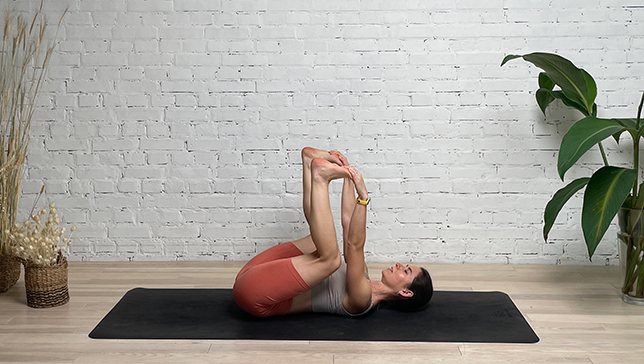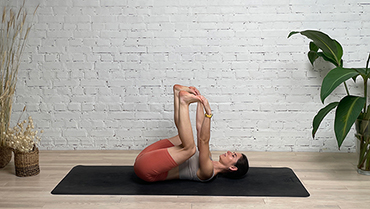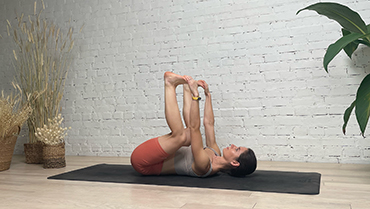Happy Baby Pose - Ananda Balasana

Contents
Happy Baby Pose or Ananda Balasana in Sanskrit (‘Ananda’ means ‘Happy’ and ‘Bala’ means a ‘Baby’) is an excellent grounding pose. Interestingly, it is also called the Dead Bug Pose, because of the position that the body takes up while performing this pose.
This yoga pose is considered one of the restorative poses which can be done for better sleep and full body relaxation. Apart from that the pose stretches the inner groins and the back spine, thus Ananda Balasana works as a soft hip opener.
Happy Baby Pose is considered a base pose as happy baby pose variations can be derived from this pose.
Pose Detail
- Difficulty: Beginners
- By Type: Flexibility Yoga Poses, Hip Opening Yoga Poses, Restorative Yoga Poses
- Body Position: Supine Yoga Poses
- By Benefit: Yoga Poses For Anxiety And Panic Attack, Yoga Poses For Sleep, Yoga Poses For Stress Relief
Step-by-Step Instructions
Benefits and Contraindications
Gently stretches the inner groins and the back spine.
Calms the brain and helps relieve stress and fatigue.
Pregnancy
Knee injury
Neck injury, support head on a thickly folded blanket
Photo poses in different angles


Useful Tips
As you practice Ananda Balasana, focus on releasing any tension in your hips and lower back. You can also gently rock from side to side to massage your spine and release any tightness in your lower back.
If you have any knee or hip injuries, it is important to modify the pose or avoid it altogether.
If you can’t reach your feet, try using a belt or scarf looped around each arch of the foot.
You can also take hold of your ankles or shins.
Modifications And Props For Beginners
If you are uncomfortable with the pose, you can always modify it with the help of yoga props. Here are some recommendations to make Happy Baby more comfortable:
- Use a Strap: If you can’t reach your feet with your hands, you can use a strap to make the pose more accessible. Wrap the strap around the arches of your feet and hold onto the strap instead of your feet. This will help you to keep your arms straight and lengthen your spine.
- Use Blocks: If you have tight hips or lower back, you can place blocks under your hips to lift them up and support your back. This will help you to relax into the pose and release tension in your hips.
- Use Blankets: If you have sensitive knees, you can fold a blanket and place it under your knees for extra support. This will help to cushion your knees and make the pose more comfortable.
- Use a Bolster: If you want to deepen the stretch in your hips, you can place a bolster or a folded blanket between your thighs and hold onto the ends of the bolster with your hands. This will help you to gently pull your thighs towards your chest and deepen the stretch in your hips.
Happy Baby Pose Anatomy
Happy Baby Pose primarily targets the hips, lower back, and inner thighs. Let’s take a closer look at the anatomy of this pose:
- Hips: The pose stretches the hip flexors, adductors, and gluteus muscles. The external rotation of the hips in this pose also engages the piriformis muscle, which can help to release tension in the lower back and hips.
- Lower Back: a gentle stretch of the muscles around the lumbar spine. The pose also encourages the sacrum to release down towards the mat, which can help to alleviate lower back pain.
- Inner Thighs: As you open your knees wide in Ananda Balasana, you stretch the inner thighs or adductors. This can help to release tension in the groin and improve flexibility in the hips.
- Core: Although Ananda Balasana is primarily a stretching pose, it also engages the core muscles to help stabilize the torso. As you hold the pose, focus on drawing your navel towards your spine and engaging your core muscles to support your lower back.
Frequently Asked Questions
Modifications & Variations
- Half Happy Baby Pose
- Rocking Happy Baby
- Happy Baby Pose Bolster Under Sacrum
- Happy Baby Pose With Bolster
- Half Happy Baby Pose
- Wide-Legged Happy Baby